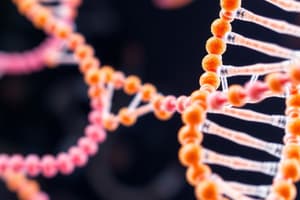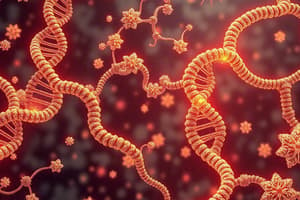Podcast
Questions and Answers
Which statement correctly describes the structural differences between purines and pyrimidines?
Which statement correctly describes the structural differences between purines and pyrimidines?
- Pyrimidines contain both adenine and guanine.
- Purines have two rings and nine atoms. (correct)
- Pyrimidines contain two rings and nine atoms.
- Purines have one ring and six atoms.
What is the function of nucleotides aside from forming nucleic acids?
What is the function of nucleotides aside from forming nucleic acids?
- They are solely responsible for energy metabolism.
- They act as monomers for carbohydrates.
- They play a role in energy metabolism such as ATP, UTP, GTP. (correct)
- They are involved in protein synthesis only.
Which of the following nitrogenous bases is exclusive to RNA?
Which of the following nitrogenous bases is exclusive to RNA?
- Adenine
- Cytosine
- Thymine
- Uracil (correct)
How does the structure of 2-deoxyribose differ from ribose?
How does the structure of 2-deoxyribose differ from ribose?
What is the role of phosphate groups in nucleotides?
What is the role of phosphate groups in nucleotides?
Which of the following statements about nucleic acids is accurate?
Which of the following statements about nucleic acids is accurate?
What characteristic differentiates nucleosides from nucleotides?
What characteristic differentiates nucleosides from nucleotides?
Which nitrogenous base is common to both DNA and RNA?
Which nitrogenous base is common to both DNA and RNA?
What is the main component of the backbone of DNA?
What is the main component of the backbone of DNA?
Which nucleotide pairing is specifically noted for having three hydrogen bonds?
Which nucleotide pairing is specifically noted for having three hydrogen bonds?
What feature distinguishes the directionality of the two strands of DNA?
What feature distinguishes the directionality of the two strands of DNA?
Which nitrogenous base is found in RNA but not in DNA?
Which nitrogenous base is found in RNA but not in DNA?
How are nucleotides linked in the nucleic acid backbone?
How are nucleotides linked in the nucleic acid backbone?
Which RNA type is primarily responsible for carrying genetic information from DNA to ribosomes?
Which RNA type is primarily responsible for carrying genetic information from DNA to ribosomes?
What is the effect of the hydrogen bonds in the double stranded DNA?
What is the effect of the hydrogen bonds in the double stranded DNA?
Which type of RNA has the clover-leaf structure?
Which type of RNA has the clover-leaf structure?
What percentage equality is observed regarding the nitrogenous bases in DNA?
What percentage equality is observed regarding the nitrogenous bases in DNA?
What is the significance of the orientation of the phophate-sugar backbone in nucleic acids?
What is the significance of the orientation of the phophate-sugar backbone in nucleic acids?
Flashcards
Nucleic Acids
Nucleic Acids
Biomolecules that carry genetic information and are involved in energy metabolism.
Nucleotide
Nucleotide
The monomer unit of nucleic acids, composed of a nitrogenous base, a pentose sugar, and a phosphate group.
Nitrogenous Base (Types)
Nitrogenous Base (Types)
Heterocyclic organic compounds classified as purines (two rings) or pyrimidines (one ring).
Pentose Sugar (Types)
Pentose Sugar (Types)
Signup and view all the flashcards
Phosphate Group
Phosphate Group
Signup and view all the flashcards
DNA
DNA
Signup and view all the flashcards
RNA
RNA
Signup and view all the flashcards
Purines
Purines
Signup and view all the flashcards
Nucleotide Structure
Nucleotide Structure
Signup and view all the flashcards
Nucleic Acid Backbone
Nucleic Acid Backbone
Signup and view all the flashcards
5' end
5' end
Signup and view all the flashcards
3' end
3' end
Signup and view all the flashcards
DNA Structure
DNA Structure
Signup and view all the flashcards
Base Pairing
Base Pairing
Signup and view all the flashcards
Primary Structure (Nucleic Acids)
Primary Structure (Nucleic Acids)
Signup and view all the flashcards
Study Notes
Nucleic Acid Structure and Function
- Building blocks: Amino acids (proteins), monosaccharides (carbohydrates), fatty acids (lipids)
- Nucleic acids: DNA and RNA, biomolecules responsible for transferring genetic information.
- Nucleotides: Monomers comprising nucleic acids. Composed of nitrogenous base, a pentose sugar, and a phosphate group.
- Nitrogenous bases: Two types: Purines (adenine, guanine) and pyrimidines (thymine, cytosine, uracil)
- Purines have two rings.
- Pyrimidines have one ring
- Uracil (U) is found only in RNA.
- Thymine (T) is found only in DNA.
- DNA: Always in the nucleus of eukaryotes (e.g., plants, animals)
- RNA: Found in the cytoplasm and prokaryotes
- Nucleosides: Nitrogenous bases linked to pentose sugars
- Phosphate groups: Linked to the 5' carbon of the pentose sugar via an ester bond. Usually in the form of mono, di, or triphosphate.
Nitrogenous Bases
- Pyrimidine: Uracil (U), thymine (T), cytosine (C)
- Purine: Adenine (A), guanine (G)
Pentose Sugar
- Ribose: Found in RNA
- 2-Deoxyribose: Found in DNA
Phosphate Group
- Phosphoric acid (H3PO4): Present in nucleotides, often as di- or triphosphate.
Nucleotide Structure
- Nucleotides linked via phosphodiester bonds, forming a backbone.
- 5' end has a free phosphate, and 3' end has a free hydroxyl group.
- Nucleic acids written 5' to 3'.
DNA Structure
- Primary structure: Sequence of nucleotides.
- Secondary structure: Double helix with two antiparallel strands; stabilized by hydrogen bonds between complementary base pairs (adenine with thymine, guanine with cytosine).
- Base pairing: Guanine pairs with cytosine (three hydrogen bonds); adenine pairs with thymine (two hydrogen bonds).
RNA Structure
- Primary structure: Sequence of nucleotides.
- Types of RNA: mRNA, tRNA, rRNA.
- mRNA: Carries genetic information from DNA to ribosomes for protein synthesis.
- tRNA: Transfers amino acids to ribosomes.
- rRNA: Forms ribosomes, where proteins are synthesized.
Studying That Suits You
Use AI to generate personalized quizzes and flashcards to suit your learning preferences.




